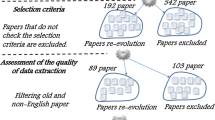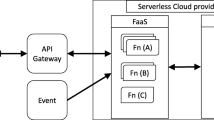Abstract
Load balancing mechanism in technologies such as cloud computing has provided a huge opportunity for the development of large-scale projects. Although the conventional view is to build mechanisms that adopt a dynamic load balancing strategy, existing strategies cannot automatically scale platform (network) servers (nodes) to adapt for dynamic requests, but only guarantee load balancing for the pre-deployed nodes, thereby increasing resource consumption and decreasing networks’ efficiency. We contend that existing load balancing mechanisms are inadequate for deploying dynamic applications. In this regard, we first adopt both load balancing and cloud computing virtualization technologies to modularly design a load balancing mechanism that provides a dynamically auto-scalable solution for large-scale and dynamic computing scenarios. Furthermore, we adopt the proof-of-work consensus, for a novel use during the lifecycle of master nodes in case of system failure caused by a failed master node, to demonstrate a fault-tolerant load balancing mechanism. We theoretically evaluate the security requirement of our mechanism and analyze its performance. Experimental results show that the mechanism supports auto-scalability and has a better performance compared to existing mechanisms such as the ordinary cluster.
Similar content being viewed by others
References
Miao Y B, Liu X M, Choo K K R, et al. Fair and dynamic data sharing framework in cloud-assisted internet of everything. IEEE Int Things J, 2019, 6: 7201–7212
Mahato D P, Singh R S. Load balanced transaction scheduling using honey bee optimization considering performability in on-demand computing system. Concurr Comput-Pract Exper, 2017, 29: 4253
Thai M T, Lin Y D, Lin P C, et al. Towards load-balanced service chaining by Hash-based traffic steering on softswitches. J Netw Comput Appl, 2018, 109: 1–10
Kouchaksaraei H R, Dräxler S, Peuster M, et al. Programmable and flexible management and orchestration of virtualized network functions. In: Proceedings of European Conference on Networks and Communications, Ljubljana, 2018
Dezhabad N, Sharifian S. Learning-based dynamic scalable load-balanced firewall as a service in network function-virtualized cloud computing environments. J Supercomput, 2018, 74: 3329–3358
Wang Q, Zhu M J, Yu Y R, et al. A load balance mechanism in heterogeneous network based on utility function. J Commun, 2016, 11: 871–878
Mohanty S, Patra P K, Ray M, et al. An approach for load balancing in cloud computing using JAYA algorithm. Int J Inf Tech Web Eng, 2019, 14: 27–41
Yang J P. Intelligent offload detection for achieving approximately optimal load balancing. IEEE Access, 2018, 6: 58609–58618
Youssef F, Habib B L E, Hamza R, et al. A new conception of load balancing in cloud computing using tasks classification levels. Int J Cloud Appl Comput, 2018, 8: 118–133
Judmayer A, Stifter N, Krombholz K, et al. Blocks and chains: introduction to bitcoin, cryptocurrencies, and their consensus mechanisms. Synth Lect Inf Secur Priv Trust, 2017, 9: 1–123
Zhang Y H, Deng R H, Liu X M, et al. Blockchain based efficient and robust fair payment for outsourcing services in cloud computing. Inf Sci, 2018, 462: 262–277
He Y H, Li H, Cheng X Z, et al. A blockchain based truthful incentive mechanism for distributed P2P applications. IEEE Access, 2018, 6: 27324–27335
Nakamoto S. Bitcoin: a peer-to-peer electronic cash system. 2008. http://www.spacepirates.com/bitcoin.pdf
Liu X M, Qin B D, Deng R H, et al. A privacy-preserving outsourced functional computation framework across large-scale multiple encrypted domains. IEEE Trans Comput, 2016, 65: 3567–3579
Chen L, Xu L, Gao Z M, et al. Protecting early stage proof-of-work based public blockchain. In: Proceedings of the 48th Annual IEEE/IFIP International Conference on Dependable Systems and Networks Workshops, Luxembourg, 2018. 122–127
Bentov I, Lee C, Mizrahi A, et al. Proof of activity: extending bitcoin’s proof of work via proof of stake [extended abstract]y. SIGMETRICS Perform Eval Rev, 2014, 42: 34–37
Huang W H, Ma Z, Dai X F, et al. Fuzzy clustering with feature weight preferences for load balancing in cloud. Int J Soft Eng Knowl Eng, 2018, 28: 593–617
Zhao J, Yang K, Wei X H, et al. A heuristic clustering-based task deployment approach for load balancing using Bayes theorem in cloud environment. IEEE Trans Parallel Distrib Syst, 2016, 27: 305–316
Miao Y B, Ma J F, Liu X M, et al. Practical attribute-based multi-keyword search scheme in mobile crowdsourcing. IEEE Int Things J, 2018, 5: 3008–3018
Mohiuddin I, Almogren A. Workload aware VM consolidation method in edge/cloud computing for IoT applications. J Parallel Distrib Comput, 2019, 123: 204–214
Carneiro T, da Nobrega R V M, Nepomuceno T, et al. Performance analysis of Google Colaboratory as a tool for accelerating deep learning applications. IEEE Access, 2018, 6: 61677–61685
Grevet C, Choi D, Kumar D, et al. Overload is overloaded: email in the age of Gmail. In: Proceedings of SIGCHI Conference on Human Factors in Computing Systems, Toronto, 2014. 793–802
Kumar L, Mutanga O. Google earth engine applications since inception: usage, trends, and potential. Remote Sens, 2018, 10: 1509
O’Brien P, Young S W H, Arlitsch K, et al. Protecting privacy on the web: a study of HTTPS and google analytics implementation in academic library websites. Online Inform Rev, 2018, 42: 734–751
Tan W A, Lu G Z, Sun Y, et al. A concurrent level based scheduling for workflow applications within cloud computing environment. In: Proceedings of Joint International Conference on Pervasive Computing and the Networked World, Vina del Mar, 2013. 400–411
Chen J, Wang Q G, Zhu S N. An improvement on load-balancing on Linux virtual server for internet-based laboratory. In: Proceedings of the 12th IEEE International Conference on Control and Automation, Kathmandu, 2016. 685–689
Chi X N, Liu B C, Niu Q, et al. Web load balance and cache optimization design based Nginx under high-concurrency environment. In: Proceedings of the 3rd International Conference on Digital Manufacturing and Automation, Guilin, 2012. 1029–1032
Sahana S, Mukherjee T, Sarddar D. A conceptual framework towards implementing a cloud-based dynamic load balancer using a weighted round-robin algorithm. Int J Cloud Appl Comput, 2020, 10: 22–35
Hussein W, Peng T, Wang G J. A weighted throttled load balancing approach for virtual machines in cloud environment. Int J Comput Sci Eng, 2015, 11: 402–408
Vukolic M. The quest for scalable blockchain fabric: proof-of-work vs. BFT replication. In: Proceedings of International Workshop on Open Problems in Network Security, Zurich, 2015. 112–125
Naoumov N, Ross K. Exploiting P2P systems for DDoS attacks. In: Proceedings of the 1st International Conference on Scalable Information Systems, Hong Kong, 2006
Mainkar V. Availability analysis of transaction processing systems based on user-perceived performance. In: Proceeding of the 16th Symposium on Reliable Distributed Systems, North Carolina, 1997. 10–16
Kavi K M, Youn H Y, Shirazi B A, et al. A performability model for soft real-time systems. In: Proceeding of the 27th Annual Hawaii International Conference on System Sciences, Maui, 1994. 571–580
Acknowledgements
This work was supported in part by Key Program of National Natural Science Foundation of China (NSFC) (Grant No. U1405255), in part by Shaanxi Science & Technology Coordination & Innovation Project (Grant No. 2016KTZDGY0506), in part by Fundamental Research Funds for the Central Universities (Grant No. SA-ZD161504), in part by National Natural Science Foundation of China (Grant No. 61702404), in part by Fundamental Research Funds for the Central Universities (Grant No. JB171504), in part by Project Funded by China Postdoctoral Science Foundation (Grant No. 2017M613080), in part by Major Nature Science Foundation of China (Grant Nos. 61370078, 61309016), in part by Key Research and Development Plan of Jiangxi Province (Grant No. 0181ACE5002).
Author information
Authors and Affiliations
Corresponding author
Rights and permissions
About this article
Cite this article
Feng, X., Ma, J., Liu, S. et al. Auto-scalable and fault-tolerant load balancing mechanism for cloud computing based on the proof-of-work election. Sci. China Inf. Sci. 65, 112102 (2022). https://doi.org/10.1007/s11432-020-2939-3
Received:
Revised:
Accepted:
Published:
DOI: https://doi.org/10.1007/s11432-020-2939-3




